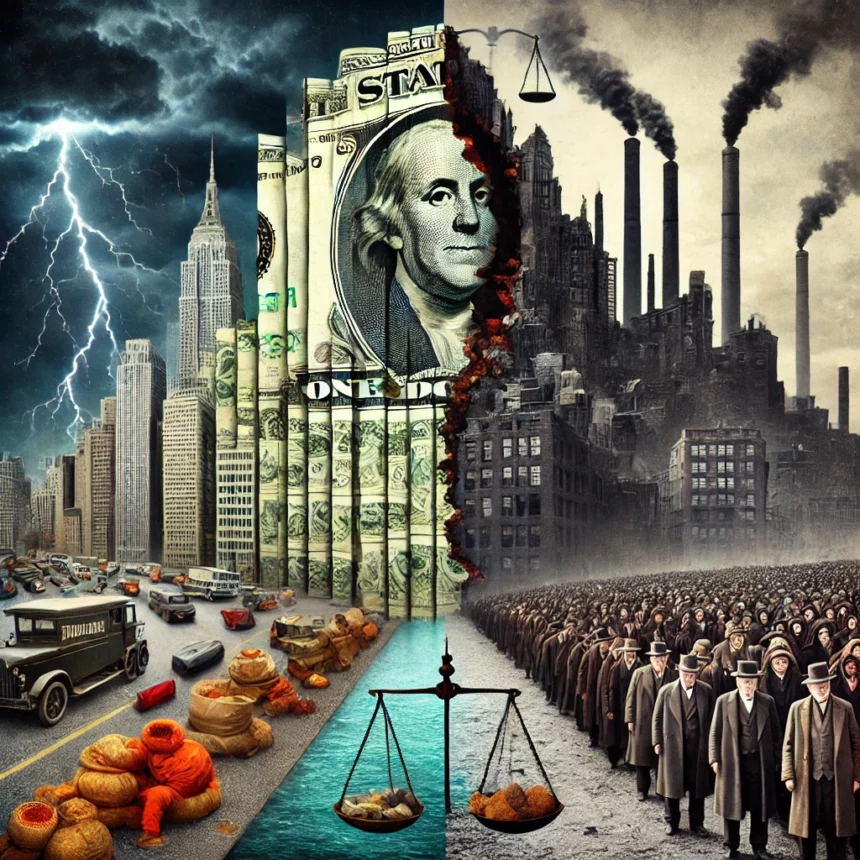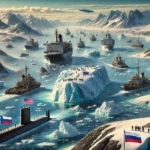The essay provides a comprehensive analysis of economic problems, highlighting similarities between the present circumstances and the events that occurred before the Great Depression in the 1920s.
Key points:
Wage and wealth inequality
The essay emphasizes the parallelism between the present disparity in income and wealth and the circumstances that existed in the late 1920s. During that time, the gap between the wealthy and the working class widened, as advancements in technology made farming and industry more efficient for those who could afford the latest machinery. This resulted in a major percentage of the people being left behind.
Currently, we are confronted with similar conditions in which a minority of the population holds the majority of wealth, and this issue is exacerbated by the slow pace of energy growth. As energy resources grow more scarce or expensive, the wealthy portion of the population obtains a benefit in terms of their capacity to make financial investments, while the working class faces challenges owing to the increasing cost of living.
The Correlation Between Debt Levels and Interest Rates
The gross federal debt-to-GDP ratio, as shown in Figure 1 of the article, indicates that the level of U.S. government debt has reached historically high levels. This quantity is considered hazardous, especially when it exceeds 90%, a limit set by economists Reinhart and Rogoff.
Moreover, there has been fluctuation in interest rates over the years, as shown in Figure 2, with a noticeable increase in 10-year treasury interest rates, particularly after 2020. The essay recognizes the Federal Reserve’s ability to oversee short-term interest rates, but argues that it is more difficult to manage longer-term rates, particularly those that affect mortgages, due to market dynamics.
The current problem lies in the fact that the combination of rising interest rates and already high levels of debt will exert considerable pressure on government budgets. This could ultimately result in the necessity for additional borrowing just to fulfill interest payment commitments. This cycle may not be sustainable in the long run.
The impact of energy supply on economic growth.
A crucial argument suggests that the ongoing growth of the economy depends on a gradual increase in accessible energy supplies. Figure 6 in the article illustrates a gradual decline in the rate of growth of energy resources since 1950.
During the eras from 1950 to 1970 and 1971 to 1980, the rise in energy consumption corresponded with the growth of the economy. Nevertheless, in recent years, specifically since 1981, the United States economy has consistently expanded despite a decline in energy consumption rates. This is mostly due to the delegation of manufacturing to external sources and the transition towards an economy that is primarily focused on providing services.
The essay posits that the transient sustenance of GDP expansion was expedited by the delegation of industrial manufacturing to nations like China, who reap advantages from reduced energy expenditures. Nevertheless, it is evident that this approach is not sustainable in the long term, primarily due to the slowdown in the expansion of global energy resources.
The Economic Vulnerability
The essay posits that contemporary economies are fragile, mostly due to the sluggish growth of energy resources in relation to the population’s increase. This worsens income disparities and overall susceptibility.
The analogy of “musical chairs” is used to depict a situation where diminishing or costlier energy supplies lead to a decrease in resource availability, resulting in a growing number of individuals lacking the necessary resources for their well-being, similar to players being left without a chair when the music stops.
Historical Comparisons to the 1920s
The essay identifies numerous parallels between the current period (2008-2023) and the 1920s. Both periods have witnessed negligible expansion in energy use, an increasing disparity in wealth, and a growing dependence on consumer borrowing.
There is a notable discrepancy between the high levels of debt at present and the depletion of most cheap energy resources. In the 1920s, the combination of industrialization and ample resources, namely fossil fuels, enabled economic expansion, although there were some inequalities. Conversely, the present sluggish pace of energy growth is seen as a limiting factor for future economic growth.
Potential Outcomes
The essay speculates about potential ramifications, suggesting that the economy is transitioning from growth to decline. As energy becomes more scarce, it becomes less feasible to borrow money for economic expansion. This leads to challenges in repaying debt, decreasing prices of assets like houses, farms, and commercial properties, and possible cases of failure to repay.
Moreover, it highlights the historical connection between economic downturns and the outbreak of armed conflict or social unrest, as evidenced by the Great Depression and the events leading up to World War II.
Possible Consequences
Possible consequences of the current path may entail stock market crashes and decreases in the values of residential properties, agricultural lands, and other forms of assets. The report emphasizes that speculative bubbles, such as those observed in 1929 and 2008, are caused by low short-term interest rates. It implies that a similar occurrence may happen again.
Following instances of debt defaults, several industries such as banks, insurance companies, pension funds, and bondholders would experience negative effects, as the value of assets declines and the ability to repay loans becomes more difficult.
Political Solutions
The essay compares alternate treatments put out by different political ideologies. Donald Trump’s strategy involves implementing protectionist measures, such as raising tariffs, to reduce reliance on imported goods and encourage the use of domestic resources. The author suggests that this strategy could be successful in the central and southern parts of the United States, where there is a higher concentration of natural resources.
The author regards Kamala Harris’s measures, such as the imposition of a cap on food prices, as problematic. The essay argues that the implementation of these restrictions would lead to farmers ceasing their agricultural activities and a reduction in imports. Consequently, this could exacerbate the current scarcity of energy and food, leading to the depletion of grocery store shelves.
Economic collapse and warfare
The author postulates that economies have the ability to segregate according to geographical boundaries. In the United States, specific regions, notably those in the central and southern sections of the country that endorse President Trump’s ideologies, might contemplate the prospect of operating independently, depending on their own energy and resources. Coastal areas that share Harris’s values may face possible confrontations with resource-rich countries like Russia and China.
The essay emphasizes that a future conflict, like to World War II, might potentially boost the Gross Domestic Product (GDP). However, it also recognizes that coastal regions, which heavily rely on foreign trade, would encounter challenges in producing weapons without depending on imports.
Energy and environmental concerns
The article examines the limitations of renewable energy, emphasizing that renewable technologies (such as solar, wind, and electric cars) are still dependent on the fossil fuel infrastructure for their manufacturing and maintenance. As fossil fuel stocks diminish, the ability to sustain these technologies will be limited.
Despite concerted efforts to reduce CO2 emissions, global emissions continue to rise as a result of the shifting of manufacturing operations to different locations, particularly non-OECD countries. This action illustrates the difficulties of environmental measures that concentrate on lowering emissions without tackling the bigger issue of energy supply.
Overview and Hypothesis
The report highlights the susceptibility of the current economic system and the limited resources available to governments for promoting further growth. The statement questions the efficacy of debt-fueled remedies in a shrinking economy.
The author postulates that there might be a division of economies or political borders, leading to prosperous regions with ample resources and struggling regions facing challenges such as food and energy shortages, which could eventually result in hostilities.
In summary, the study warns that the lack of an abundant and affordable energy source could make future economic growth impossible, perhaps resulting in economic stagnation, increasing debt, and possibly societal collapse, similar to the aftermath of the 1920s.
Read the full article here.







